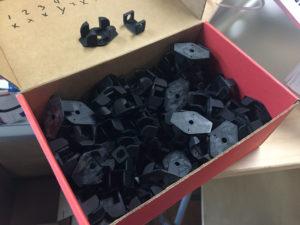Have you been watching the Olympics this past week? This coming weekend is going to be a big one for track and field, which has always been one of my favorites. I’m in awe of the capabilities of all Olympian athletes, but as a former runner, I’m particularly amazed by track champions. Running is hard, and running well is more than just being fast. It involves careful planning, pacing, assessment of your environment and competitors – it’s a more cerebral sport than many people realize.
Proper pacing is especially important, and especially challenging, even for professional runners. Most runners, at one point or another, have blown a race or even injured themselves by running too hard too early, burning themselves out before the critical last leg of the race. It’s not something you’d think 3D printing could help with, or even have anything remotely to do with, but – surprise! – it turns out that it can and does.
 Learning how to pace oneself is a critical part of a runner’s training, but it’s tricky; many runners pace themselves against other people, but other people aren’t always consistent or pacing wisely themselves. Alexandra Kline, an engineering student at California Polytechnic State University, came up with a new idea – why not create a digital pace-setter? She approached digital design company Viget, who loved the idea and started developing it right away.
Learning how to pace oneself is a critical part of a runner’s training, but it’s tricky; many runners pace themselves against other people, but other people aren’t always consistent or pacing wisely themselves. Alexandra Kline, an engineering student at California Polytechnic State University, came up with a new idea – why not create a digital pace-setter? She approached digital design company Viget, who loved the idea and started developing it right away.
The concept involves a long strip of LED lights that encircles the inner perimeter of the track and is connected via Bluetooth to a smartphone app. The app allows coaches to set speed, distance, intervals and even light color (to set the pace for multiple runners at a time). Runners then pace themselves against the light, which moves around the track perimeter according to the app’s settings. The coach can also monitor the runners directly within the app.
The technology, now called TrackPacer, is still in the prototype stage, but it’s received great feedback from the universities and professional runners who have tested it so far. To get the system up and running as quickly as possible, Viget turned to a LulzBot Mini 3D printer to print ratchet connectors that attach the LED strips to the track. According to Justin Sinichko, a hardware developer at Viget, 3D printing was the only way to go for this part of the project.
“We wanted a way to quickly get this thing on the track without going down the injection molding route,” Sinichko said. “It would’ve been impossible without 3D printing.
“Throughout the course of a 400-meter track, there’s the potential to really mess up some distances, and for anything that’s pace-based, you’ve got to have distance and time spot on. That connector empowers you to do two things: One, get that thing on the track, but two, also make sure that they’re exactly where we need them to be and make slight adjustments over the course of 400 meters.”
It took less than a week to print all of the necessary connectors, with the LulzBot Mini running consistently and printing multiple connectors at one time. Sinichko praised the simplicity and reliability of the printer, as well as the Cura LulzBot Edition software – particularly the Quickprint Profiles that were introduced in the latest update of the software.
“Cura LulzBot Edition by far is so simple to use [and a] great slicer utility,” Sinichko said. “We were trying to find a utility that the whole office could use, and the default profiles…solve 99.9 percent of what we’re trying to do.”
The next step will be taking the technology from prototype to product. The final version will likely be produced by different means, but for the 400-meter, 12,000-LED prototype, 3D printing was the perfect option. In Sinichko’s opinion, every product development lab should have a 3D printer. It saves time, it saves money, and consequently saves both agency and client a lot of stress. Discuss further in the 3D Printed Mini Pacer forum over at 3DPB.com.
[Source: LulzBot]
Subscribe to Our Email Newsletter
Stay up-to-date on all the latest news from the 3D printing industry and receive information and offers from third party vendors.
You May Also Like
3D Printing News Briefs, April 13, 2024: Robotics, Orthotics, & Hypersonics
In 3D Printing News Briefs today, we’re focusing first on robotics, as Carnegie Mellon University’s new Robotics Innovation Center will house several community outreach programs, and Ugogo3D is now working...
Rail Giant Alstom Saves $15M with 3D Printing Automation Software 3D Spark
3D Spark has entered into a three-year deal with the rail giant Alstom. Alstom, a transport behemoth with annual revenues of $16 billion, specializes in the manufacture of trains, trams,...
Meltio Expands Global Reach with New Partnerships in the Americas and Europe
Spanish 3D printing manufacturer Meltio has expanded its sales network across the globe. With the addition of three new partners in the United States, Brazil, Argentina, and Italy, Meltio aims...
3D Printing Webinar and Event Roundup: April 7, 2024
Webinars and events in the 3D printing industry are picking back up this week! Sea-Air-Space is coming to Maryland, and SAE International is sponsoring a 3D Systems webinar about 3D...


































